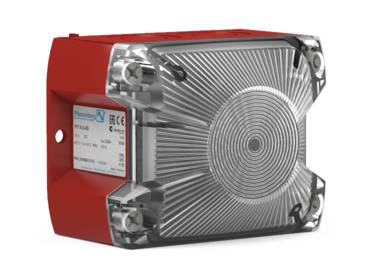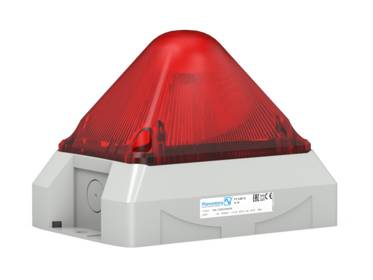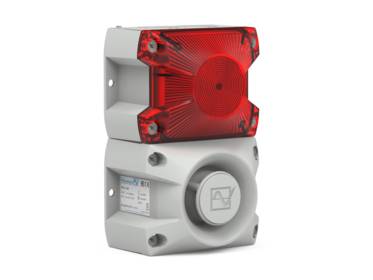Case Study
Hekatron has focussed all its experience, competence and innovation on developing and producing systems for preventive technical fire protection for 50 years. Safety – a fundamental human need, which we and the 22 other subsidiaries and 9,000 employees of the family run Securitas Group Switzerland are taking on. The delivery program, produced at the highest quality level “Made in Germany”, comprises fire alarm systems, controlling fire extinguishing systems, holdopen systems for fire protection barriers, mechanical smoke extraction, smoke detection in ventilation ducts, universal management systems, smoke alarms and special solutions.
EN 54-23 – Hekatron and Pfannenberg explain
EN 54-23 – Increased requirements made to visual signaling devices mean that special attention must be paid to select the correct products in the respective application.
One of the tasks for the manufacturers of fire alarm systems is to provide norm compliant components in their systems. Furthermore, appropriate educational work still needs to be carried out by constructors, planners, operators and experts. In accordance with Pfannenberg’s motto “Sharing Competence”, Hekatron and Pfannenberg are accomplishing this task together: they provide norm compliant units by using signaling devices that have recently been added to the system approval and ensure the education work of all involved parties.
In most European countries, the new norm EN 54-23 for visual signaling devices came into effect on 1st January 2014. Visual and visual-audible sounders that were previously approved may no longer be used in new installations. The demands of these product standards are currently being revised in the planning and project design regulations of the VDE 0833-2. Therefore, there is presently a grey zone until these requirements are implemented across all norms.
Safety for man and machine
Safe and prompt fire alerting is important, not only in production (traditional industry), but also in administration and in public buildings. In these areas, fire alarm systems have the advantage that fires can be detected quickly regardless of whether people are present or not, and appropriate measures can then be taken. People who have been alerted can, in individual cases, act early on and extinguish a fire when it is still in its initial phase. The top priority is the protection of people but also of material assets. Fire alarm systems are required according to building regulations and are regulated within the framework of special building regulations. For the planning of fire alarm systems which are in accordance with building regulations, the requirements of DIN 14675 are used. The design and components are regulated in the VDE 0833-2. The parts themselves are defined in the series standards EN 54.
Audible signaling devices have always been a fixed component of fire alarm systems. In the era of increasingly growing ambient influences, especially of the audible kind, the exclusive audible alerting in dangerous situations has to be analysed and reassessed according to the changed ambient conditions. In addition to the requirement that ear protection must be worn at the workplace, other disruptive audible factors have long since become embedded into normal life. Hence, it is extremely difficult to discern between signals that inform and signals that alert. A large variety of noises due to technology such as, for example, the confirmation signal of a machine, but also the wearing of media players contribute to the fact that audible alarm signals are either not heard or simply not deemed relevant. A visual-audible alerting for example is always required when the so-called ambient noise level is already very high and it is not a given that an audible signal will definitely be heard.
Yet it is not only the continuously increasing “acoustic smog” that is making it difficult to hear and recognise an alarm signal correctly: According to estimates by the World Health Organisation from 2005, 278 million people are affected by mildly to seriously impaired hearing. For those affected, a purely audible alerting is not effective. Therefore, in compliance with the German Equal Opportunities for People with Disabilities Act, visual signaling devices are increasingly becoming mandatory as a supplement to the audible signals.
EN 54-23 takes this growing need for visual signaling devices into account and determines the requirements to visual signaling devices. With that, it also allows a comparison of different light sources for example Xenon or LED. Thus, it is determined which performance characteristics the devices need to have to be used in the fire detection zone.
Which requirements does EN 54-23 stipulate?
EN 54-23 (visual signaling devices) was developed as a supplement to EN 54-3 (audible signaling devices). In contrast to EN 54-3, EN 54-23 gives direct information regarding the planning and use of visual signaling devices. Thus, it is for example stipulated which lighting intensity (lx) needs to be created by the signaling device at all positions in the signal reception range. Further, the devices are classified in three categories, regardless of the intended use. In the categories “W” (wall installation) and “C” (ceiling installation), the geometry of the signal reception area is already stipulated, while the category “O” (open installation) allows the manufacturer to describe the signaling area and the characteristics of the signaling device in detail or to design it optimally for certain applications and constructions.
As geometry, the category “W” stipulates a cubic signaling range which is specified by the designation W-x-y whereby:
- x is the maximum mounting height of the signaling device on the wall given in metres (m) with a minimum value of 2.4 m; and
- y is the breadth of a square room which is lit by the signaling device given in metres (m).
Thus, “W-3.5-11.5” stands, for example, for a wall mounted signaling device with a mounting height of max. 3.5 m and a cubic signaling area of max 11.5 m × 11.5 m.
Signaling devices of the category “C” are specified with the designation C-x-y where:
- x is either 3, 6 or 9 and represents the maximum height in which the signaling device may be fixed on the ceiling, given in metres (m); and
- y is the diameter of the cylindrical signaling area given in metres (m), when the signaling device is fixed in the stipulated ceiling height.
Thus, “C-3-15” stands for example, for a ceiling mounted signaling device with a mounting height of max. 3m and a cylindrical signaling area of 15m diameter. Whereby the shape specification of a cylinder is, as a rule, not compatible with that of the rooms and therefore has to be recalculated into a cubic signaling area.
Normally, red or clear lights are defined as approved light colours. This colour specification applies for the so-called “designated signaling devices”, which pursues the objective of rescuing people (internal alarm). EN 54-23 does not apply to the visual signaling devices at the key depot or the initial information centre of the fire service, here other colours may continue to be used.
The correct alarm concept saves costs
In the future, as is already the case for audible signaling devices, appropriate content will be integrated into the alarm concept also for visual signaling devices – here the so-called signaling areas are planned. This alarm concept will gain larger significance, as an “inflation” of the amount of signaling devices and the costs connected therewith can be prevented by giving an exact definition of the areas which need to be supplemented with visual alarms.
At the moment, it is becoming apparent that there will be two types of visual signaling devices. Devices with LED technology which are approved for the categories C and W. These devices will be used especially in the administration sector with small rooms. If the devices are to be mounted on the ceiling, then only ceiling heights of up to 3 m can be covered with the devices that are currently available. Alternatively, devices with Xenon technology are available which are increasingly available in the O category. These devices are used especially in production plants in traditional industry. In the future, there will be devices that are approved for and can cover ceiling heights of up to 13.5 m with a surface area of approx. 27 m x 25 m.
Consequently, devices that feature a significantly higher light intensity than those used in the past will be needed for larger areas and rooms. Due to the lack of guidelines, the power consumption was frequently used as a criterion for the selection of the visual signaling device, as this has a strong influence on the emergency power supply. In the future there will be new performance indicators, such as the relative power input per m³.
When selecting and planning visual signaling devices it will be necessary in the future to choose the suitable signaling devices in the planning stage and to define them in accordance with the requirements from the alerting concept. A direct comparability from product to product is not given as the signaling ranges of the signaling devices available on the market vary.
Hekatron relies on signaling devices form the PYRA® and PATROL series
Hekatron relies on signaling devices from the PYRA® and PATROL seriesHekatron counts on signaling devices from the PYRA® and PATROL series for industrial applications. In these surroundings, higher requirements to signaling devices prevail in comparison to public administration buildings. In these applications, the PYRA® and PATROL series in IP 66 and IK08 meet the requirements of a high IP system of protection as well as having an impact-proof housing. Furthermore, the connection terminals in the base, undetachable seals and quick locking elements facilitate mounting.
EN 54-23 certified products
Summary
When the EU standard EN 54-23 was introduced on 1st January 2014, the requirements made to the visual alerting of people increased significantly. Certified visual and/or visual-audible signaling devices for fire alarm systems became mandatory. Additionally, EN 54-23 places special requirements on light intensity and light distribution.
In many alerting cases, in which up to now only audible signals have been used, visual alerting must now be used too. The basis for this is the alarm concept that is to be created according to DIN 14675 and VDE 0833-2. More significance is placed on this concept and also on the planning of signaling ranges.
Task
- Constantly growing ambient influences – especially audible nature
- Higher noise levels
- People with mildly impaired to seriously impaired hearing
- Increase of number of signaling devices and the related costs
Challenges
- protection of sensitive electronics in electrical enclosures against too high temperatures to occur expensive downtime
- reliable solutions with small maintenance costs
Technique applied
- Flashing lights from the PYRA®-series
- Flashing light sounders from the PATROL-series
Success factors
- High IP system of protection (IP 66)
- Impact-proof housing
- Quick mounting due to connection terminals in the base, undetachable seals, quick locking elements
| Description | Langue | Type | Dimensions | Téléchargement |
|---|---|---|---|---|
Case Study Hekatron |
|
640 KB | Téléchargement |



